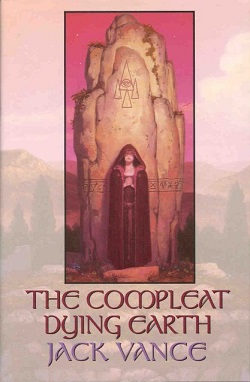
Dying Earth is a fantasy series by the American author Jack Vance, comprising four books originally published from 1950 to 1984. Some have been called picaresque. They vary from short story collections to a fix-up, perhaps all the way to novel.
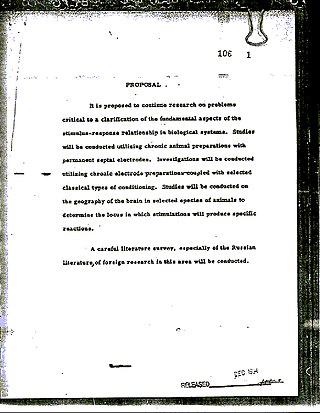
Project MKUltra was an illegal human experiments program designed and undertaken by the U.S. Central Intelligence Agency (CIA) to develop procedures and identify drugs that could be used during interrogations to weaken people and force confessions through brainwashing and psychological torture. It began in 1953 and was halted in 1973. MKUltra used numerous methods to manipulate its subjects' mental states and brain functions, such as the covert administration of high doses of psychoactive drugs and other chemicals without the subjects' consent, electroshocks, hypnosis, sensory deprivation, isolation, verbal and sexual abuse, and other forms of torture.

Edmund Alexander Emshwiller was an American visual artist notable for his science fiction illustrations and his pioneering experimental films. He usually signed his illustrations as Emsh but sometimes used Ed Emsh, Ed Emsler, Willer and others.

Destination: Void is a science fiction novel by American author Frank Herbert, the first of four novels in the Pandora Sequence series. It first appeared in Galaxy Magazine—illustrated by John Giunta—in August 1965, under the title "Do I Wake or Dream?", but was published in book form as Destination: Void the following year. A revised edition, edited and updated by the author, was released in 1978. The book stands alone but the story is continued - and embellished with more details of the Moonbase project and the history of the clones - in Herbert's other novels The Jesus Incident, The Lazarus Effect and The Ascension Factor, co-authored by Bill Ransom.
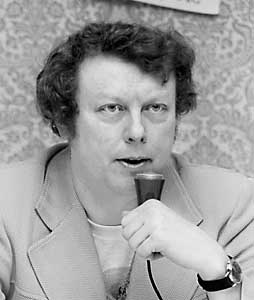
Gordon Rupert Dickson was a Canadian-American science fiction writer. He was inducted into the Science Fiction and Fantasy Hall of Fame in 2000.
The Internet Speculative Fiction Database (ISFDB) is a database of bibliographic information on genres considered speculative fiction, including science fiction and related genres such as fantasy, alternate history, and horror fiction. The ISFDB is a volunteer effort, with the database being open for moderated editing and user contributions, and a wiki that allows the database editors to coordinate with each other. As of April 2022, the site had catalogued 2,002,324 story titles from 232,816 authors.

Exultant is a science fiction novel by British author Stephen Baxter. It is part two of the Destiny's Children series. The book was published by Victor Gollancz Ltd in September 2004.
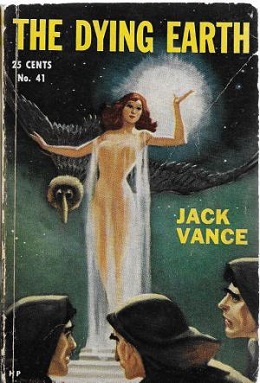
The Dying Earth is a collection of science fantasy/fantasy short fiction by American writer Jack Vance, published by Hillman in 1950. Vance returned to the setting in 1965 and thereafter, making it the first book in the Dying Earth series. It was retitled Mazirian the Magician in the Vance Integral Edition (2005), according to Jack Vance's expressed preference.
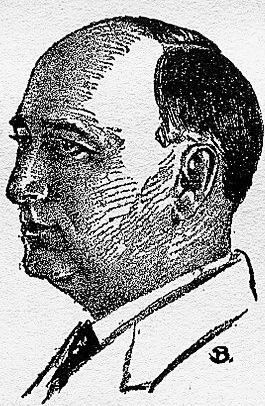
David Henry Keller was an American writer who worked for pulp magazines in the mid-twentieth century, in the science fiction, fantasy, and horror genres. He was also a psychiatrist and physician to shell-shocked soldiers during World War I and World War II, and his experience treating mentally ill people is evident in some of his writing, which contains references to mental disorders. He initially wrote short stories as a hobby and published his first science fiction story in Amazing Stories in 1928. He continued to work as a psychiatrist while publishing over sixty short stories in science fiction and horror genres. Technically, his stories were not well-written, but focused on the emotional aspects of imaginative situations, which was unusual for stories at the time.

"Kid Stuff" is a science fiction short story by American writer Isaac Asimov. It was first published in the September 1953 issue of Beyond Fantasy Fiction and reprinted in the 1957 collection Earth Is Room Enough. Asimov wrote the story in January 1953, intending it for a new magazine called Fantastic, but it was rejected by its editor, Harold Browne. Asimov then submitted it to H. L. Gold, who accepted it for a new sister magazine of Galaxy Science Fiction called Beyond Fantasy Fiction.
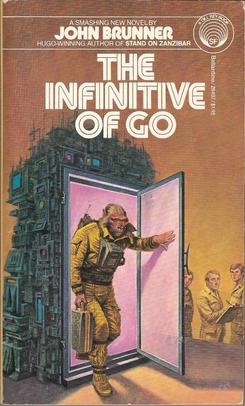
The Infinitive of Go is a 1980 science fiction novel by British writer John Brunner.
"The Imaginary" is a science fiction short story by American writer Isaac Asimov. It first appeared in the November 1942 issue of Super Science Stories and was reprinted in the 1972 collection The Early Asimov. Following the sale of "Half-Breeds on Venus", which was a sequel to "Half-Breed", Asimov suggested to Astounding Science Fiction editor John W. Campbell that he write a sequel to the story "Homo Sol". Campbell was unenthusiastic, but agreed. Since "The Imaginary" lacked the human-alien conflict that he had liked in the earlier story, Campbell ultimately rejected it. "The Imaginary" was the twenty-first story written by Asimov, and the twenty-ninth to be published. Due to the peculiar workings of the science fiction magazine publishing industry, "The Imaginary" appeared a month after the third story in the Homo Sol Trilogy, "The Hazing".

Pegasus in Flight (1990) is a science fiction novel by American writer Anne McCaffrey set in her "Talents Universe". It is the sequel to a 1973 collection of short stories, To Ride Pegasus, and its 2000 sequel Pegasus in Space completed a trilogy.
"Button, Button" is a science fiction short story by American writer Isaac Asimov. The story first appeared in a January 1953 issue of Startling Stories and was reprinted in the 1975 collection Buy Jupiter and Other Stories. It is one of several stories by Asimov in which he deliberately set out to be funny.
"Breeds There a Man...?" is a science fiction short story by American writer Isaac Asimov. It was first published in the June 1951 issue of Astounding and was reprinted in science fiction anthologies such as Beachheads in Space (1952) and The Great SF Stories #13 (1951), as well as in Asimov-only collections such as Through a Glass, Clearly (1967), Nightfall and Other Stories (1969). and Robot Dreams (1986).
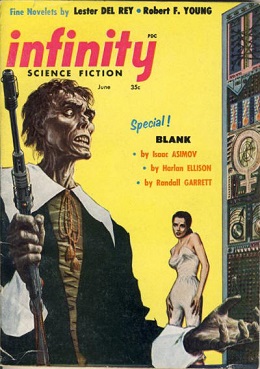
"Blank!" is a science fiction short story by American writer Isaac Asimov. It was commissioned by Larry Shaw, editor of Infinity Science Fiction, as being the least inspirational title on which to base a story. Harlan Ellison and Randall Garrett were also invited to submit stories based on the same title; Garrett wrote one with "Blank?" as the title while Ellison submitted "Blank." All three were published in the magazine in June 1957. Asimov's story was later reprinted in the 1975 collection Buy Jupiter and Other Stories.
"Weatherman" is a science fiction short story by American writer Lois McMaster Bujold, first published in the February 1990 issue of Analog Science Fiction and Fact. It was later included in The Space Opera Renaissance collection. Written as a prelude story starring a character used by Bujold in the Vorkosigan Saga, it was republished as the first six chapters of The Vor Game. "Weatherman" was nominated for the Nebula Award for Best Novella, while The Vor Game won the Hugo Award for Best Novel.
"Slow Sculpture" is a science fiction short story by American writer Theodore Sturgeon. First published in the Galaxy Science Fiction issue of February 1970, it won the 1970 Nebula Award for Best Novelette and the 1971 Hugo Award for Best Short Story.
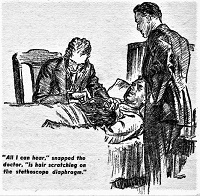
"Hyperpilosity" is a science fiction story by American writer L. Sprague de Camp. It was first published in the magazine Astounding Stories for April, 1938, and first appeared in book form in the de Camp collection The Wheels of If and Other Science Fiction (Shasta, 1949; It later appeared in the anthologies Omnibus of Science Fiction, Science Fiction of the Thirties, The Edward De Bono Science Fiction Collection, and The Road to Science Fiction #2: From Wells to Heinlein, as well as the magazine Fantastic Story Magazine and the de Camp collection The Best of L. Sprague de Camp. In 2014 the story was shortlisted for the Retro Hugo Award for Best Short Story.

"The Merman" is a science fiction story by American writer L. Sprague de Camp, based on the concept of human biological engineering. It was first published in the magazine Astounding Science-Fiction for December, 1938. It first appeared in book form in the collection The Wheels of If and Other Science Fiction ; it later appeared in the anthology Science Fiction of the Thirties and the collection The Best of L. Sprague de Camp. The story has been translated into German











